Themed collection Emerging Investigators 2016: Novel design strategies for new functional materials

Profile: Emerging Investigators 2016: novel design strategies for new functional materials
Journal of Materials Chemistry A profiles contributors to the Emerging Investigators issue.
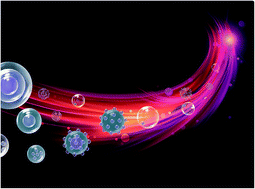
J. Mater. Chem. A, 2016,4, 6670-6679
https://doi.org/10.1039/C6TA90084D
Rational design and fabrication of core–shell nanoparticles through a one-step/pot strategy
This article provides an overview of recent developments in the fabrication of core–shell nanoparticles by one-step/pot methodologies as well as providing a summary and outlook of this emerging area.
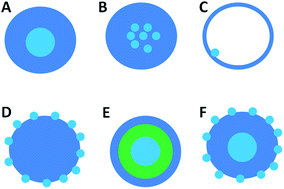
J. Mater. Chem. A, 2016,4, 6680-6692
https://doi.org/10.1039/C5TA09607C
A review of one-dimensional TiO2 nanostructured materials for environmental and energy applications
State-of-the-art development of fabrication methods and surface engineering strategies of 1D TiO2 nanostructures is reviewed, and an overview given of their potential applications including pollutant degradation/CO2 photoreduction photocatalysts, water splitting, solar cells, lithium-ion batteries and supercapacitors.
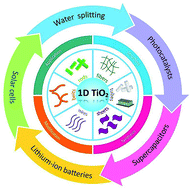
J. Mater. Chem. A, 2016,4, 6772-6801
https://doi.org/10.1039/C5TA09323F
First row transition metal catalysts for solar-driven water oxidation produced by electrodeposition
Herein we discuss catalysts for the water oxidation half-reaction of electrochemical water splitting that can be produced by electrodeposition and that are based on the comparatively plentiful and inexpensive first row transition metals.
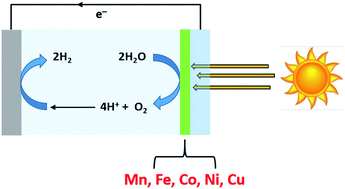
J. Mater. Chem. A, 2016,4, 6724-6741
https://doi.org/10.1039/C5TA09423B
Recent advancements in perovskite solar cells: flexibility, stability and large scale
This review focuses on the aspects of flexibility, stability and large scale, which are very essential for the future commercialization of PSCs, and many effective materials and fabrication strategies which have been reported to emphasize these three properties of PSCs will be introduced.
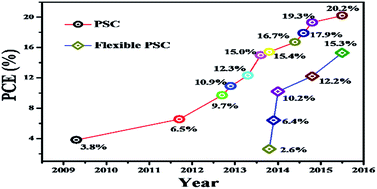
J. Mater. Chem. A, 2016,4, 6755-6771
https://doi.org/10.1039/C5TA09661H
Design of nitride semiconductors for solar energy conversion
Nitride semiconductors have properties suitable for solar energy conversion and can be synthesized using high-energy precursors.
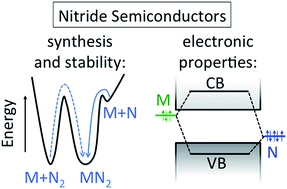
J. Mater. Chem. A, 2016,4, 6742-6754
https://doi.org/10.1039/C5TA09446A
The lighter side of MOFs: structurally photoresponsive metal–organic frameworks
Shedding light on the design strategies used to make structurally photoactive metal–organic frameworks.

J. Mater. Chem. A, 2016,4, 6714-6723
https://doi.org/10.1039/C5TA09424K
Organometal halide perovskite thin films and solar cells by vapor deposition
Vapor based methods provide a promising alternative way to fabricate organometal halide perovskite solar cells.

J. Mater. Chem. A, 2016,4, 6693-6713
https://doi.org/10.1039/C5TA08963H
Hybrid organic–inorganic solar cells based on bismuth iodide and 1,6-hexanediammonium dication
Heavy metal toxicity and device instability are prominent limitations in the push for commercialization of photovoltaics based on low-cost, solution-processed materials. Therefore, in this study a hybrid organic–inorganic material containing trivalent bismuth and dicationic 1,6-hexanediammonium was used as the photoactive layer in solution-processed photovoltaics.

J. Mater. Chem. A, 2016,4, 6837-6841
https://doi.org/10.1039/C6TA00517A
Oxygen evolution reaction electrocatalysis on SrIrO3 grown using molecular beam epitaxy
Electrochemical generation of oxygen via the oxygen evolution reaction (OER) is a key enabling step for many air-breathing electrochemical energy storage devices.
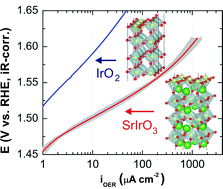
J. Mater. Chem. A, 2016,4, 6831-6836
https://doi.org/10.1039/C5TA09530A
Laser induced MoS2/carbon hybrids for hydrogen evolution reaction catalysts
The direct laser writing method has emerged as a novel technique for fabricating MoS2/carbon hybrid HER catalysts with low cost, high efficiency, and flexible designability.
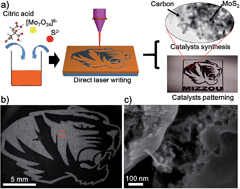
J. Mater. Chem. A, 2016,4, 6824-6830
https://doi.org/10.1039/C5TA09322H
One-step electrospinning of carbon nanowebs on metallic textiles for high-capacitance supercapacitor fabrics
We report the development of high-performance wearable supercapacitor fabrics based on flexible metallic fabrics and one-step electrospun carbon nanowebs.
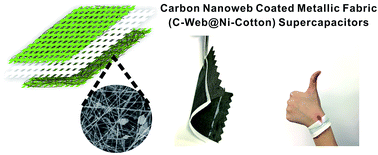
J. Mater. Chem. A, 2016,4, 6802-6808
https://doi.org/10.1039/C5TA09309K
Ammonium tetrathiomolybdate as a novel electrode material for convenient tuning of the kinetics of electrochemical O2 reduction by using iron–porphyrin catalysts
Ammonium tetrathiomolybdate modified gold electrodes can easily tune the rate of electron transfer to the redox active species when the deposition time is varied.
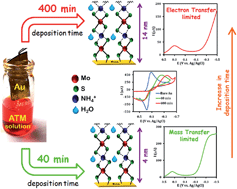
J. Mater. Chem. A, 2016,4, 6819-6823
https://doi.org/10.1039/C5TA10544G
Surface functionalization of conjugated microporous polymer thin films and nanomembranes using orthogonal chemistries
The synthesis and surface modification of CMP thin films and nanomembranes was performed using orthogonal click chemistries. The surface modification can tune the nanomembrane properties for desired applications; the use of photo-initiated reactions provides the additional opportunity to photo-pattern the CMP materials.
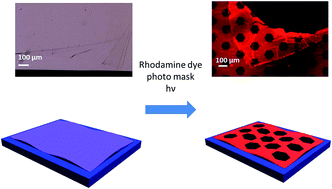
J. Mater. Chem. A, 2016,4, 6815-6818
https://doi.org/10.1039/C5TA09429A
Colloidal Sb2S3 nanocrystals: synthesis, characterization and fabrication of solid-state semiconductor sensitized solar cells
Antimony sulfide nanocrystals of various shapes and different phases are synthesized using a colloidal hot-injection method, and the as-prepared nanocrystals are used as a light harvesting material in photovoltaic devices.
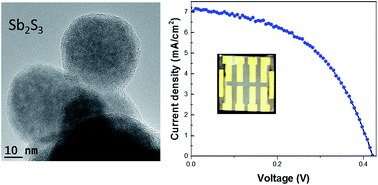
J. Mater. Chem. A, 2016,4, 6809-6814
https://doi.org/10.1039/C5TA09546H
The formation mechanism of Janus nanostructures in one-pot reactions: the case of Ag–Ag8GeS6
Using Ag–Ag8GeS6 as a model system, a novel strategy for the formation of Ag-based Janus nanostructures is presented.

J. Mater. Chem. A, 2016,4, 7060-7070
https://doi.org/10.1039/C6TA00398B
Photo-assisted electrodeposition of MoSx from ionic liquids on organic-functionalized silicon photoelectrodes for H2 generation
This work reports the synergistic utility of ionic liquid-based, photo-assisted electrodeposition of MoSx onto organic-functionalized silicon photolelectrodes for dihydrogen (H2) evolution under 1-sun illumination.
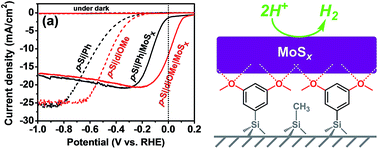
J. Mater. Chem. A, 2016,4, 7027-7035
https://doi.org/10.1039/C5TA09684G
Radicals in carbonaceous residue deposited on mordenite from methanol
EPR spectroscopy and DFT calculations identify naphthalenium and anthracenium radicals in high temperature coke residue deposited on methanol fed H-MOR.

J. Mater. Chem. A, 2016,4, 7036-7044
https://doi.org/10.1039/C6TA01053A
Plasmonic substrates comprising gold nanostars efficiently regenerate cofactor molecules
Gold nanostars as a photocatalyst perform better than rods and cubes.
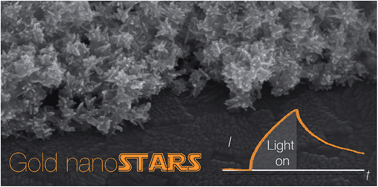
J. Mater. Chem. A, 2016,4, 7045-7052
https://doi.org/10.1039/C6TA01770C
Inexpensive colloidal SnSb nanoalloys as efficient anode materials for lithium- and sodium-ion batteries
The quest for higher energy densities of lithium-ion batteries (LIBs) and emerging sodium-ion analogues (SIBs) has motivated an intense research effort toward novel electrode materials.
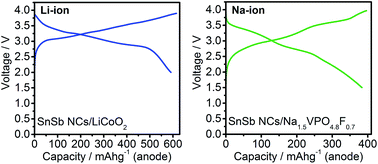
J. Mater. Chem. A, 2016,4, 7053-7059
https://doi.org/10.1039/C5TA10568D
Iron–cobalt bimetal decorated carbon nanotubes as cost-effective cathode catalysts for Li–O2 batteries
FeCo bimetal decorated CNTs were synthesized as highly efficient and cost-effective non-noble metal catalysts for Li-O2 batteries.
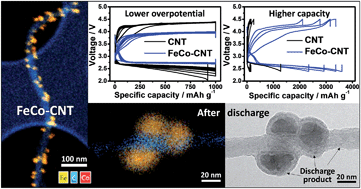
J. Mater. Chem. A, 2016,4, 7020-7026
https://doi.org/10.1039/C5TA10550A
Design of CO2 sorbents using functionalized fibrous nanosilica (KCC-1): insights into the effect of the silica morphology (KCC-1 vs. MCM-41)
Hybrid materials by functionalization of fibrous nanosilica (KCC-1) were synthesized for efficient CO2 capture, using various amine molecules by physisorption (ads.) as well as covalent attachment.
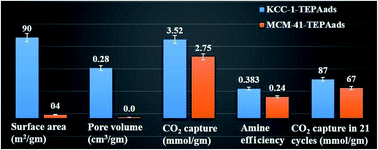
J. Mater. Chem. A, 2016,4, 7005-7019
https://doi.org/10.1039/C6TA01348A
Feeling the strain: enhancing ionic transport in olivine phosphate cathodes for Li- and Na-ion batteries through strain effects
Olivine-type phosphates LiFePO4 and NaFePO4 are among the most widely studied cathode materials for rechargeable batteries. Here we show that tensile strain applied perpendicularly to the alkali-ion migration channels will improve their intercalation properties.

J. Mater. Chem. A, 2016,4, 6998-7004
https://doi.org/10.1039/C5TA09418F
Engineering the kinetics and interfacial energetics of Ni/Ni–Mo catalyzed amorphous silicon carbide photocathodes in alkaline media
The photoelectrochemical performance of a-SiC photocathodes was enhanced by using a Ni/Ni-Mo dual-catalyst resulting in a significant increase of photocurrent density of −14 mA cm−2 at 0 V vs. RHE.
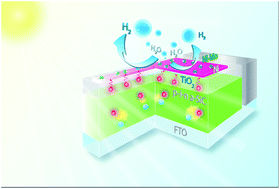
J. Mater. Chem. A, 2016,4, 6842-6852
https://doi.org/10.1039/C5TA09435F
Nature inspiring processing route toward high throughput production of perovskite photovoltaics
We report our results of developing perovskite thin films with high coverage, improved uniformity and preserved crystalline continuity in a single pass deposition.

J. Mater. Chem. A, 2016,4, 6989-6997
https://doi.org/10.1039/C5TA09992G
Photoelectrochemical water oxidation using a Bi2MoO6/MoO3 heterojunction photoanode synthesised by hydrothermal treatment of an anodised MoO3 thin film
A photoactive Bi2MoO6/MoO3 heterojunction electrode derived from a direct thin-film-route showed close to 100% faradic photocurrent-to-O2 conversion efficiency.
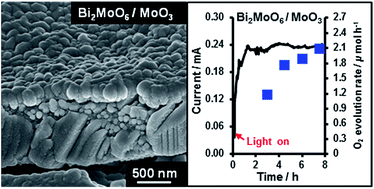
J. Mater. Chem. A, 2016,4, 6964-6971
https://doi.org/10.1039/C6TA00700G
Lithium-ion conductivity in Li6Y(BO3)3: a thermally and electrochemically robust solid electrolyte
The development of new frameworks for solid electrolytes exhibiting fast Li-ion diffusion is critical for enabling new energy storage technologies.
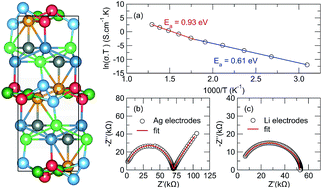
J. Mater. Chem. A, 2016,4, 6972-6979
https://doi.org/10.1039/C5TA09436D
Amino acids as highly efficient modulators for single crystals of zirconium and hafnium metal–organic frameworks
Addition of small quantities of amino acids to solvothermal and microwave syntheses of Zr and Hf MOFs drastically improves their crystallinity to the extent that single crystal structures can be obtained.
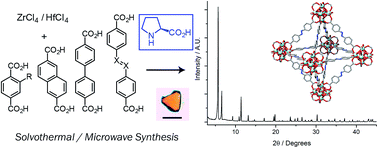
J. Mater. Chem. A, 2016,4, 6955-6963
https://doi.org/10.1039/C5TA10401G
The nature and effects of rhodium and antimony dopants on the electronic structure of TiO2: towards design of Z-scheme photocatalysts
The nature and effects of rhodium and antimony doping in TiO2 have been investigated using X-ray diffraction (XRD), X-ray Photoelectron Spectroscopy (XPS), Extended X-ray Absorption Fine Structure (EXAFS), X-ray Absorption Near Edge Structure (XANES) and diffuse reflectance spectroscopy.
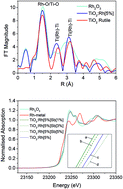
J. Mater. Chem. A, 2016,4, 6946-6954
https://doi.org/10.1039/C6TA00293E
A balancing act: manipulating reactivity of shape-controlled metal nanocatalysts through bimetallic architecture
Catalytic performance and bimetallic architecture are intertwined.

J. Mater. Chem. A, 2016,4, 6911-6918
https://doi.org/10.1039/C5TA09368F
Bio-inspired synthesis of α-Ni(OH)2 nanobristles on various substrates and their applications
A facile bio-inspired, diaphragm-assisted method is demonstrated for effective synthesis of nanostructures on substrates.
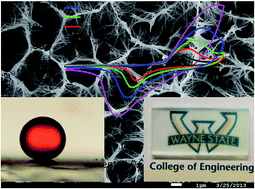
J. Mater. Chem. A, 2016,4, 6919-6925
https://doi.org/10.1039/C5TA09329E
A resource efficient design strategy to optimise the temperature coefficient of capacitance of BaTiO3-based ceramics using finite element modelling
A finite element modelling - experimental approach as a new resource efficient design strategy to improve the temperature stability of BaTiO3 (BT)-based ceramic materials for MLCCs. Illustrated using rare earth-free NaNbO3-doped BT and found to decrease the magnitude of the TCC.
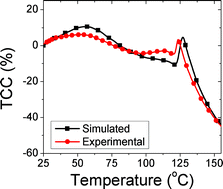
J. Mater. Chem. A, 2016,4, 6896-6901
https://doi.org/10.1039/C5TA09573E
Oxidation–reduction assisted exfoliation of LiCoO2 into nanosheets and reassembly into functional Li-ion battery cathodes
A new method to exfoliate LiCoO2 into nanosheets is presented and the structural and electrochemical properties of particles obtained from reassembled nanosheets are investigated.
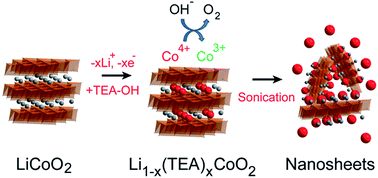
J. Mater. Chem. A, 2016,4, 6902-6910
https://doi.org/10.1039/C5TA09069E
Flexible high performance hybrid AZO/Ag-nanowire/AZO sandwich structured transparent conductors for flexible Cu(In,Ga)Se2 solar cell applications
We report on the fabrication of a robust and flexible transparent electrode to replace costly and fragile indium tin oxide used in flexible Cu(In,Ga)Se2 solar cells.
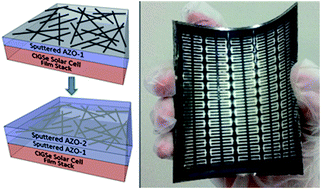
J. Mater. Chem. A, 2016,4, 6980-6988
https://doi.org/10.1039/C5TA09000H
A clear coat from a water soluble precursor: a bioinspired paint concept
Mussel-inspired copolymer P(DAA-co-AEMA) forms water-resistant coating upon pH increase by self-crosslinking reaction of catechols and amines.
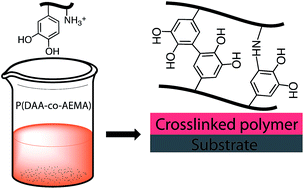
J. Mater. Chem. A, 2016,4, 6868-6877
https://doi.org/10.1039/C5TA09437B
Unravelling the nature, evolution and spatial gradients of active species and active sites in the catalyst bed of unpromoted and K/Ba-promoted Cu/Al2O3 during CO2 capture-reduction
Space- and time-resolved operando DRIFTS, XAFS, and XRD uncovered the involved surface chemical species and active sites, especially the unique functions of K and Cu, during the CO2 capture-reduction process.
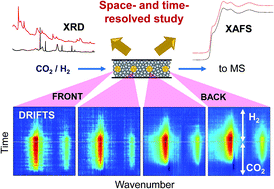
J. Mater. Chem. A, 2016,4, 6878-6885
https://doi.org/10.1039/C5TA09461E
Binder-free graphene as an advanced anode for lithium batteries
A binder-free graphene anode for Li-ion batteries showing a reversible specific capacity of ∼500 mA h g−1 after 100 cycles is demonstrated.
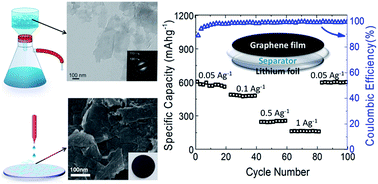
J. Mater. Chem. A, 2016,4, 6886-6895
https://doi.org/10.1039/C5TA08553E
Metallic Co9S8 nanosheets grown on carbon cloth as efficient binder-free electrocatalysts for the hydrogen evolution reaction in neutral media
We report the direct growth of metallic Co9S8 nanosheets on carbon cloth (CC), which can serve as efficient binder-free electrocatalysts for the HER in neutral media.
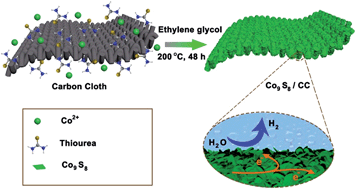
J. Mater. Chem. A, 2016,4, 6860-6867
https://doi.org/10.1039/C5TA08611F
Tailoring re-entrant geometry in inverse colloidal monolayers to control surface wettability
Two-dimensional nanopore arrays with adjustable re-entrant curvature are prepared from colloidal templating and used to pattern low-surface-tension liquids.

J. Mater. Chem. A, 2016,4, 6853-6859
https://doi.org/10.1039/C5TA08992A
Bisisoindigo: using a ring-fusion approach to extend the conjugation length of isoindigo
A new building block for organic semiconductors is synthesized, based on the ring fusion of two isoindigo groups across the 6 and 7 positions.
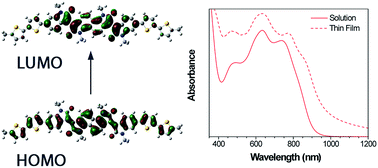
J. Mater. Chem. A, 2016,4, 6940-6945
https://doi.org/10.1039/C5TA07511D
A rechargeable self-healing safety fuel gel
The rechargeable KOH responsive self-healing gel can be used as a safe fuel for indoor and outdoor heating without any special stove or burner.

J. Mater. Chem. A, 2016,4, 6933-6939
https://doi.org/10.1039/C5TA08010J
Doping-induced structural evolution from rutile to anatase: formation of Nb-doped anatase TiO2 nanosheets with high photocatalytic activity
Semiconductor nanostructures with specially exposed reactive crystal facets are promising to promote photocatalytic/photoelectrochemical reactions.

J. Mater. Chem. A, 2016,4, 6926-6932
https://doi.org/10.1039/C5TA08202A
Correction: Design of CO2 sorbents using functionalized fibrous nanosilica (KCC-1): insights into the effect of the silica morphology (KCC-1 vs. MCM-41)
J. Mater. Chem. A, 2016,4, 7071-7071
https://doi.org/10.1039/C6TA90078J
About this collection
Journal of Materials Chemistry A is proud to present this themed issue highlighting 2016’s rising stars of materials chemistry research. This issue gathers the very best work from materials chemists in the early stages of their independent career, with a special focus on novel design strategies for new functional materials.
Each contributor was recommended by our prestigious Editorial Board as carrying out work with the potential to influence future directions in materials chemistry. Congratulations to all of those who feature on their important work so far in the field of materials for energy and sustainability.